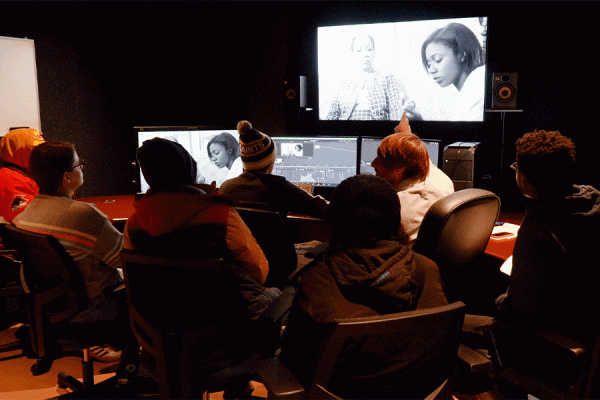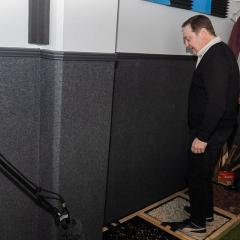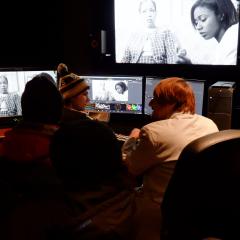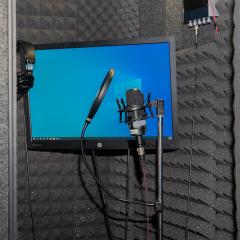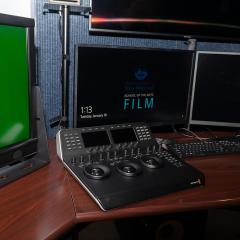The eclectic room that University of New Orleans computer and film equipment technician Aaron Rushin shows to visitors used to be a storage closet. Now, with the help of a $172,000 state grant and the imagination of film studies professor James Roe, it stores a journey into sound.
Roe, who teaches film post-production techniques, including visual effects, post-production sound and editing, turned the closet into a professional Foley suite, which is a room that filmmakers use to make sound effects in real-time for movies. Roe was the principal investigator for the Louisiana Board of Regents grant that funded key renovations and upgrades to the School of the Arts film department.
In the Foley suite, there are pods of rocks and gravel. A “closet” of clothes on hangers. Light switches. Boots and pillows—among other things—and a microphone to capture all of the sounds.
“Can you see? One might step on this to make the sound of footsteps,” Rushin said as he stepped in the gravel pod. “You can make different sounds so it is all synced to the film. This room makes things a lot easier rather than trying to have to jury-rig something post audio.”
The grant helped to update two finishing suites with faster computers, high dynamic range (HDR) monitors and expanded software capabilities that adhere to industry standard in editing, color correction and sound mixing. It also allowed for the renovation of eight editing suites to include new workstations for expanded access to the department’s editing specific software and the addition of a new computer lab.
“There are post editing facilities around the state that don’t have anything like this,” Rushin said. “We’re pretty proud of that. It’s a world-class facility.”
The grant also helped with the purchase of new LED lights that allows for the continued move from old style Tungsten and florescent lighting equipment to the new power-saver LED lights.
The enhancements will allow UNO’s program to meet current and future industry standards in film and television post-production workflows as they relate to high dynamic range and color space, Roe said.
Resolution, high dynamic range and color space are the three core technological advances in the film and television industry, Roe said. Most people are familiar with resolution, as the consumer market has moved from high definition (HD) to ultra-high definition (UHD) television, which is a higher resolution screen.
Already, broadcast networks and streaming services like Netflix require all programming to be created in UHD (4K resolution), Roe said. Resolution will continue to increase with new technological innovations, but increased resolution will have limitations, as it is often difficult for the human eye to distinguish resolutions beyond 4K, he said.
“Therefore, the industry is strongly embracing the other two aspects, dynamic range and color space,” Roe said. “Both of these elements can dramatically improve the moving image.”
The grant also funded a projection system for screening in the music department’s 300-seat Recital Hall, complete with a new 4K projector, a remote-control screen that drops from the ceiling and a new audio system.
“With this system, the film program can host guest filmmakers to screen their films, and have a larger space for online interfaces with filmmakers in Hollywood, New York and around the world,” Roe said. “We can also host film festivals, panels, networking events, and bring in A-list filmmakers to campus, boosting the image of the program and attracting students.”
The goal of the renovations, Roe said, was to provide critical infrastructure to enhance education and to enable new hands-on filmmaking methods while incorporating the new equipment into the curricula with exciting course projects that continue to prepare students for professional filmmaking.
“We already have our first film festival coming in the spring, The Overlook Film Festival, who have been on campus before and brought writer/director Robert Rodriguez and actor Elijah Wood,” said film professor Hamp Overton, who is the program’s director of film internships. “With the new projection systems, our film studies classes, such as film history, can now host lectures and view films in a movie theater-style environment.
“It’s been a lot of fun to have ready access to such a great space and see so many movies on the ‘big screen’ rather than in a classroom.”


